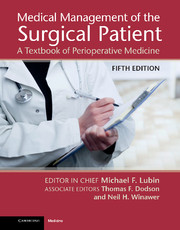Book contents
- Frontmatter
- Dedication
- Contents
- List of Contributors
- Preface
- Introduction
- Part 1 Perioperative Care of the Surgical Patient
- Part 2 Surgical Procedures and their Complications
- Section 17 General Surgery
- Chapter 47 Tracheostomy
- Chapter 48 Thyroidectomy
- Chapter 49 Parathyroidectomy
- Chapter 50 Lumpectomy and mastectomy
- Chapter 51 Gastric procedures (including laparoscopic antireflux, gastric bypass, and gastric banding)
- Chapter 52 Small bowel resection
- Chapter 53 Appendectomy
- Chapter 54 Colon resection
- Chapter 55 Abdominoperineal resection/coloanal or ileoanal anastomoses
- Chapter 56 Anal operations
- Chapter 57 Cholecystectomy
- Chapter 58 Common bile duct exploration
- Chapter 59 Major hepatic resection
- Chapter 60 Splenectomy
- Chapter 61 Pancreatoduodenal resection
- Chapter 62 Adrenal surgery
- Chapter 63 Lysis of adhesions
- Chapter 64 Ventral hernia repair
- Chapter 65 Inguinal hernia repair
- Chapter 66 Laparotomy in patients with human immunodeficiency virus infection
- Chapter 67 Abdominal trauma
- Section 18 Cardiothoracic Surgery
- Section 19 Vascular Surgery
- Section 20 Plastic and Reconstructive Surgery
- Section 21 Gynecologic Surgery
- Section 22 Neurologic Surgery
- Section 23 Ophthalmic Surgery
- Section 24 Orthopedic Surgery
- Section 25 Otolaryngologic Surgery
- Section 26 Urologic Surgery
- Index
- References
Chapter 63 - Lysis of adhesions
from Section 17 - General Surgery
Published online by Cambridge University Press: 05 September 2013
- Frontmatter
- Dedication
- Contents
- List of Contributors
- Preface
- Introduction
- Part 1 Perioperative Care of the Surgical Patient
- Part 2 Surgical Procedures and their Complications
- Section 17 General Surgery
- Chapter 47 Tracheostomy
- Chapter 48 Thyroidectomy
- Chapter 49 Parathyroidectomy
- Chapter 50 Lumpectomy and mastectomy
- Chapter 51 Gastric procedures (including laparoscopic antireflux, gastric bypass, and gastric banding)
- Chapter 52 Small bowel resection
- Chapter 53 Appendectomy
- Chapter 54 Colon resection
- Chapter 55 Abdominoperineal resection/coloanal or ileoanal anastomoses
- Chapter 56 Anal operations
- Chapter 57 Cholecystectomy
- Chapter 58 Common bile duct exploration
- Chapter 59 Major hepatic resection
- Chapter 60 Splenectomy
- Chapter 61 Pancreatoduodenal resection
- Chapter 62 Adrenal surgery
- Chapter 63 Lysis of adhesions
- Chapter 64 Ventral hernia repair
- Chapter 65 Inguinal hernia repair
- Chapter 66 Laparotomy in patients with human immunodeficiency virus infection
- Chapter 67 Abdominal trauma
- Section 18 Cardiothoracic Surgery
- Section 19 Vascular Surgery
- Section 20 Plastic and Reconstructive Surgery
- Section 21 Gynecologic Surgery
- Section 22 Neurologic Surgery
- Section 23 Ophthalmic Surgery
- Section 24 Orthopedic Surgery
- Section 25 Otolaryngologic Surgery
- Section 26 Urologic Surgery
- Index
- References
Summary
Intra-abdominal adhesions are the most common reason for mechanical small bowel obstruction (SBO) and are implicated in infertility and complex abdominal and pelvic pain. Recent studies suggest that 10% of patients who have undergone colectomy will be re-admitted for SBO within 3 years. The annual cost of managing this condition is well over 1 billion dollars.
Hyaluronate/carboxymethyl cellulose (Seprafilm), oxidized regenerated cellulose (Intercede), and other agents are available to attempt to limit postoperative adhesion formation. These agents have been shown to reduce adhesion formation, but have not been proven to decrease the incidence of SBO. Furthermore, there is a possible link to an increased incidence of anastamotic leak. Thus, utilization of these products varies by institution and surgeon. Other techniques that have been shown to decrease postoperative adhesion include a laparoscopic approach, minimization of foreign material (sutures/mesh), and use of powder-free gloves.
Patients usually present with nausea and emesis if the obstruction is complete. If the obstruction is only partial, patients may have less severe symptoms and may still be passing flatus. Many patients are profoundly dehydrated and hypokalemic and require significant resuscitation and electrolyte repletion. Patients with limited cramping and abdominal distension, and no signs of peritonitis, often benefit from fluid and electrolyte repletion, nasogastric tube decompression and observation. This approach may allow laparotomy to be avoided, but mandates close observation for signs of threatened bowel. Patients with a rising white blood cell count, fever, peritonitis, and persistent or increasing pain (possible closed loop obstruction) will likely need surgical exploration. Obstructed small bowel may become ischemic or necrotic without classical signs and symptoms; when a non-operative approach is taken, serial evaluations and a high index of suspicion are necessary.
- Type
- Chapter
- Information
- Medical Management of the Surgical PatientA Textbook of Perioperative Medicine, pp. 544 - 545Publisher: Cambridge University PressPrint publication year: 2013

